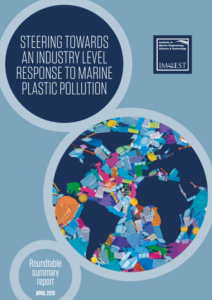Although existing regulations –particularly MARPOL and the London Convention– explicitly prohibit the dumping of plastic at sea, these frameworks have their limitations, said IMarEST in a recent report on marine plastics.
For this reason, a comprehensive review focusing on their practical implementation would identify opportunities for updating and improvements. This review would benefit from better data on plastic litter emanating from the marine industry: its type, source, and where it is frequently discarded at sea,
…the report reads.
In conjunction with the first international conference on marine plastics in late 2018, the IMarEST hosted a roundtable event with Centre for Environment, Fisheries and Aquaculture Science (Cefas) to gain fresh insights from a wider industry perspective into the challenges, management practices and attitudes of a variety of stakeholders in the marine industry regarding marine plastics. The report gives an overview of the discussions at this event.
We do not yet know the aggregate and long-term effects on ocean ecosystem services, however it is almost certain to put further pressure on fish and seafood stocks which are already strained by overfishing activities and climate change. Most plastic that finds its way into the oceans originates from land-based sources.
However, the contribution from ocean-based activities, such as commercial fishing, cargo shipping and passenger cruises, is not insignificant.
During the roundtable, it became evident that there is an appetite among all sections of the marine industry to ‘do their part in addressing the problem’.
This stemmed partly from a desire to deflect – often misconceived – criticism from the public and to demonstrate good environmental stewardship.
These right-minded intentions were, however, asterisked with a caveat: that any proposed solutions, especially compulsory regulatory measures, should not impose additional costs.
Modern shipping, in particular, is a notoriously cost-sensitive business. This suggests that the industry’s regulators should strive for policies based on a ‘polluter pays’ principle to avoid stoking resistance and resentment.
Non-onerous schemes for tallying the amount of plastic carried onboard and disposed or lost at sea would also be welcome to increase transparency and accountability.
Any regulations that are introduced must of course have teeth: they will only function effectively if properly policed and enforced. Capacity-building may be necessary for some port States, as evidenced by the noted geographical patterns in availability of reception facilities raised earlier. Cooperative efforts will be needed to support a global implementation of the regulatory framework.
Looking specifically at shipping as a source of marine plastics, it was recommended regional patterns should be studied to target new initiatives.
Research into temporal trends, geographic distribution and global cycle of plastic litter has already implicated multiple regions and shipping routes.
Further study would be valuable to help disentangle these links and extrapolate relationships with marine and land-based commercial activities.
However, these studies should align with the ongoing work of the International Maritime Organization (IMO) to develop an action plan for tackling plastics [generated by international shipping]. For example, there is still limited quantitative data for some regions, particularly in the southern hemisphere and remote regions including the West Indian Ocean and East Asia which has been previously raised by The Joint Group of Experts on the Scientific Aspects of Marine Environmental Protection (GESAMP).
Explore more herebelow:































































